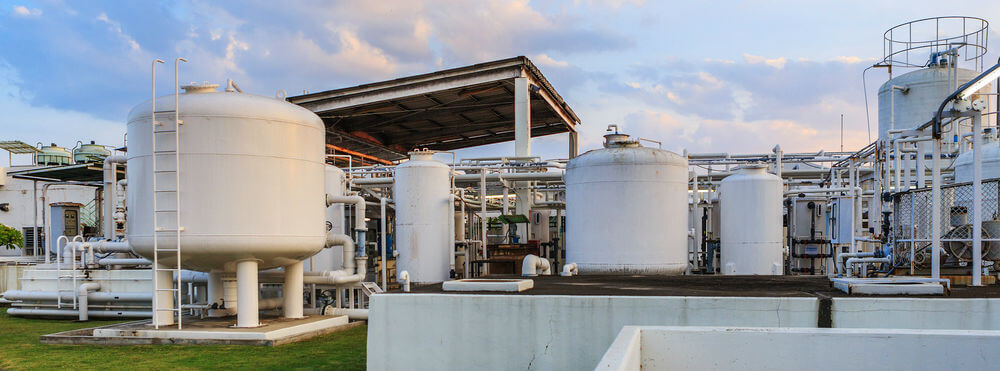How Is Nitrogen Produced for Industrial Applications?
April 14, 2020

In many manufacturing processes, the use of large volumes of nitrogen is crucial to success. From food and beverage manufacture, winery, and oil and gas processes such as nitrogen blanketing and gas purging, large volumes of nitrogen are needed to facilitate these processes.
A significant challenge that industrial operators may face is deciding the best method of generating the required industrial nitrogen gas supply. While some processes may run on nitrogen supplied by an external source, most process plant managers will opt for on-site nitrogen generation.
So, how is nitrogen produced? This article outlines the methods currently being employed to generate nitrogen on an industrial scale.
What Is Nitrogen Gas?
Nitrogen gas is an inert element occurring abundantly in nature both free and as part of industrially significant compounds. Gaseous nitrogen is colorless, odorless, tasteless, and has inert properties.
While these properties make it ideal for use in various industrial processes, they also make it a potential safety hazard to personnel. As a result, appropriate nitrogen safety precautions must be followed by nitrogen gas manufacturers and users.
Common Industrial Uses of Nitrogen Gas
The manufacture of nitrogen gas has countless applications, especially in the oil and gas industry. Some of the key uses of industrial nitrogen are outlined below.
- Nitrogen blanketing
- Nitrogen purging
- Nitrogen injection/ Gas lifting
- Gas-assisted injection molding
- Nitrogen Sparging for Wine
Gas Blanketing
A critical nitrogen gas application is the blanketing of storage tanks for volatile chemical compounds. Due to its inert nature, nitrogen blanketing within storage units will keep unstable hydrocarbons from undergoing hazardous chemical reactions.
Nitrogen Purging
Nitrogen gas with its low reactivity can be introduced into industrial gas lines and other volatile processes to displace oxygen and other gases more prone to spontaneous combustion or oxidation. Nitrogen purging will keep manufacturing processes within stable and safe limits.
Nitrogen Injection/ Gas Lifting
As an enhanced oil recovery technique, nitrogen generated by various standard methods can be introduced into an oil reservoir when formation pressures start to dwindle. These secondary recovery techniques will restore and prolong well productivity for as long as possible.
Gas-assisted Injection Molding
A well-known and effective method of shaping plastics involves the use of gas to manipulate the molten materials into the desired shapes. Many industrial operators incorporate a nitrogen manufacturing process in their plastic casting procedure. The use of nitrogen in place of traditional molding methods, produces even, well-crafted products with minimal filling errors/ defects.
Winery
Winemaking processes require brewers to delicately balance various factors to yield high-quality wine. Significant concerns winemakers face is the risk of oxidation which will alter the flavor and quality of their brews. Nitrogen sparging can be safely undergone to eliminate oxygen and other gaseous impurities in wine as well as flushing and blanketing process containers.
3 Common Types of Nitrogen Gas Production
So, how is nitrogen made? The three main techniques used in the industrial preparation of nitrogen gas are listed below:
- Pressure swing adsorption
- Membrane nitrogen generation
- Fractional distillation
1. Pressure Swing Adsorption (PSA) Nitrogen Production
This method of production of nitrogen gas relies on the ability of adsorbent material to separate a gaseous mixture into its components. Pressure swing adsorption is a two-stage nitrogen making process that involves adsorption and desorption ongoing simultaneously in two generation towers.
Get a quote on our GENERON® PSA Nitrogen Generators today!
Adsorption
This first stage requires the use of an adsorptive tower filled with a molecular carbon sieve material, which selectively retains oxygen while allowing nitrogen to pass into a collecting tank. This process will continue until the adsorptive tower reaches its maximum saturation point.
Desorption
This is the second step in a PSA nitrogen generation process and is essentially a reversal of the adsorption process. Once the saturation point for an adsorptive tower is reached, its function is changed, and oxygen is released from it to regenerate the sieve material to enable another cycle of adsorption.
2. Membrane Nitrogen Production
Membrane nitrogen generation uses a semi-permeable membrane to achieve the separation of a stream of air into its component gases using their varied speeds of travel. The hollow fiber membrane module is designed to facilitate faster rates of permeation by providing a larger surface area for the gas stream.
A typical membrane nitrogen generator has these components:
- Feed filter coalescers
- Immersion heaters
- Activated carbon filters
- Particulate filters
Get a quote on our GENERON® Membrane Nitrogen Generators today!
3. Fractional Distillation Nitrogen Production
Fractional distillation is a highly effective method of generating nitrogen for industrial use. The process involves the supercooling of air to its liquefaction point and then distilling its component gases at their various boiling points. This process will yield nitrogen with a high purity but is generally more costly than PSA or Membrane production.
GENERON Has Efficient Nitrogen Generation Solutions
GENERON is committed to providing customers like you with the most efficient nitrogen generation solutions. Our services are targeted at achieving maximal industrial productivity while remaining cost-effective.
Our nitrogen generators incorporate the latest in membrane and adsorption technology which makes them uniquely suited to a broad range of industrial applications.
Contact GENERON today for more information about the nitrogen generation services we offer.
